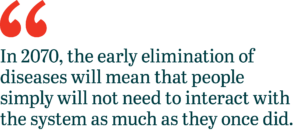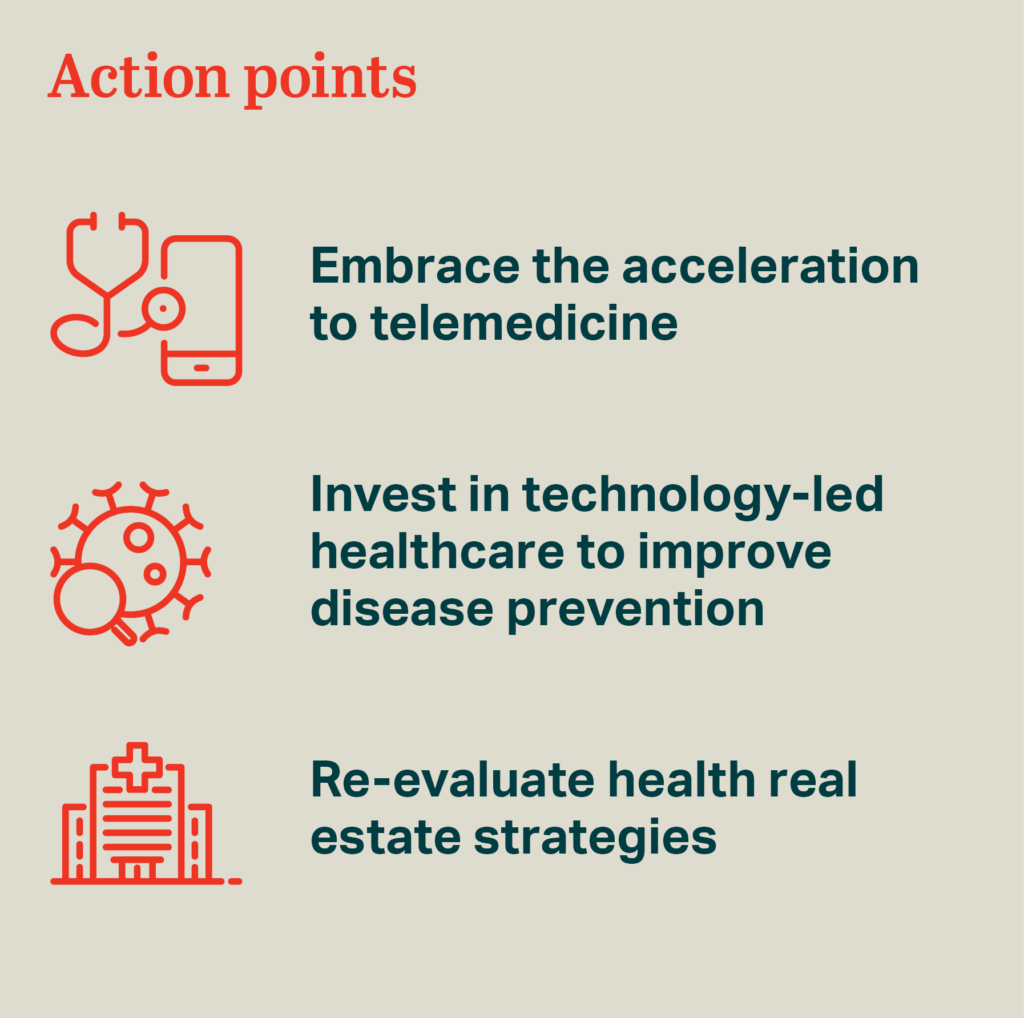Imagining the future of healthcare delivery in 2070
What will healthcare delivery look like in fifty years’ time? By 2070, real estate will be optimised to support personalised and genetic-led preventative treatment at home says Healthcare and Science Sector Leader, Richard Mann.
The coronavirus pandemic, technology advances and climate change are radically changing our approach to and reliance upon healthcare, which is increasingly informed by science-based evidence. Real estate is having to adapt, but what does the future really hold for healthcare delivery?
In our London 2070 report, which sets out our vision for the future city region, experts and thought leaders from across AECOM pooled their knowledge and aspirations. We imagined what a resilient, interconnected, responsible and balanced city region might look like in fifty years’ time. Healthcare delivery was an important part of that conversation.
In this first half of this article, we look at how current trends may shape health real estate strategies over the next five decades (listing action points), and in the second half we imagine what healthcare delivery and real estate might look like in a world where personalised and genetic-led preventative treatments have become the norm.
Where we are now and where we are going
Technology is constantly changing the working methodologies of doctors and surgeons. 3D imaging and laser technologies are facilitating less invasive, successful treatments while implantable medical devices can automatically monitor and regulate a raft of health conditions. Doctors can now work remotely and even perform robotic surgery.
The coronavirus pandemic caused a shift to remote diagnosis and treatments, and this will accelerate the development and adoption of technology-led healthcare as we move forward. There are many positives to this, though the challenges of how best to deliver local and personal patient care as well as targeting provision to reduce health inequalities will need to be addressed. We anticipate that this technology-led approach will lead to a rethink of health real estate strategies and will also stretch health and social care services to consider how and where healthcare is delivered, particularly as changing demographics will mean there are more older people to look after.
 Gradually, we expect that the cost of healthcare delivery from added demands of an aging population will be tempered by a preventative-led approach, informed by studies such as one published by the Journal of Epidemiology & Community Health (2017) which showed for every £1 invested in public health there is an average £14 saving in future healthcare costs. In the near future, wearable devices will transmit data from implants providing frontline care and advice in the home through AI-led algorithms. Secure data will be shared via the cloud to enable personalised genomic-led prevention and treatment to tackle the increasing prevalence of chronic conditions. The UK government has already set out its ambitions to create the most advanced genomic healthcare system in the world by 2030[1] which will be stimulated by the work underway in the innovative economic clusters across city regions and their health, research and university clusters.
Gradually, we expect that the cost of healthcare delivery from added demands of an aging population will be tempered by a preventative-led approach, informed by studies such as one published by the Journal of Epidemiology & Community Health (2017) which showed for every £1 invested in public health there is an average £14 saving in future healthcare costs. In the near future, wearable devices will transmit data from implants providing frontline care and advice in the home through AI-led algorithms. Secure data will be shared via the cloud to enable personalised genomic-led prevention and treatment to tackle the increasing prevalence of chronic conditions. The UK government has already set out its ambitions to create the most advanced genomic healthcare system in the world by 2030[1] which will be stimulated by the work underway in the innovative economic clusters across city regions and their health, research and university clusters.
Successive digital strategies[2] to join up health and care data, along with the Centre for Digital Built Britain (National Digital Twin Programme) proposals such as the one for London’s Healthcare Infrastructure (LHI), are already informing the OneLondon digital approach, which aims to ensure clinicians across the capital have access to patient information at the point of care. This is being adopted in other city regions, and nationally.
But the move to a future healthcare approach is not solely about treating physical health. Increasing the use of technology and automation must not sacrifice healthcare’s important role in supporting individual and community wellbeing or the resilience of public health services, including the ability to tackle future pandemics through local action.
Consequently, we also anticipate a renewed focus on mental health, accompanied by a workstyle evolution, as flexible working and a reduced-hours working week become the norm. In Japan, Microsoft has seen a 40 per cent increase in productivity after switching to a four-day working week, while Sweden and Finland are planning similar moves. Cutting the working week could enhance wellbeing and free up more time for self-development and community-centred activities such as volunteering, mentoring and providing extended social care – all part of rebalancing our lives with a greater focus on civic purpose and shared community responsibility.
Heathcare delivery in 2070
 By 2070 the innovations and application of technologies developed in the health-tech clusters of the city and region will have had a profound effect on the delivery of healthcare services. With widespread adoption of genomic-led treatments that lessen the day-to-day demands on the system, healthcare real estate, as we know it, shrinks as delivery is liberated from place-specific constraints. Instead, the focus evolves into person-centric, preventative care supported by secure data sharing through the region’s highly-developed digital connectivity.
By 2070 the innovations and application of technologies developed in the health-tech clusters of the city and region will have had a profound effect on the delivery of healthcare services. With widespread adoption of genomic-led treatments that lessen the day-to-day demands on the system, healthcare real estate, as we know it, shrinks as delivery is liberated from place-specific constraints. Instead, the focus evolves into person-centric, preventative care supported by secure data sharing through the region’s highly-developed digital connectivity.
The early elimination of diseases will mean that people simply will not need to interact with the system as much as they once did, most notably in the types of facilities that deliver reactive acute care, such as hospitals.
Underpinning this model of care, the healthcare system will be organised around health management in the home. In the medium to long term, telemedicine will be the norm, with diagnostics and examination coming to the patient rather than the reverse. Low cost drones will securely distribute medication and in-home diagnostic equipment will allow community healthcare professionals to focus on personal care and engagement.
Health management in the home will be supported by a network of connected smart ‘hives’, so-called because they take inspiration from the community and support offered by beehives. These “hives” will serve a number of functions related to the ongoing survival of the colony and the success of the hive is entirely dependent on the coordinated actions of individuals working together. In a similar way, healthcare hives will draw together healthcare professionals and community volunteers to meet local needs. In 2070, our integrated care system will comprise community-based Health and Wellbeing Hives (H&W Hives) and regional Medi-Hives, centres of excellence for acute and chronic conditions,
-

Community-based H&W Hives will be at the heart of personalised delivery when light-touch, generic patient intervention is required With the majority of primary healthcare delivered in the home, community-based H&W Hives will be at the heart of personalised delivery when light-touch, generic patient intervention is required, dealing with all non-emergency acute care, also providing mindfulness, self-care advice and mental health treatment.
Located in ‘civic hubs’ in repurposed buildings on local high streets, the H&W Hives will be highly valued by the communities that they serve. For many, the H&W Hives will be a short walk away or easily accessible by autonomous pods. The H&W Hives will be further supported by diagnostics vehicles carrying compact technical equipment which will be able to make hyper-local journeys within local communities. By 2070, understanding around early years development in relation to wellbeing and mental health will be well-developed[3]. People suffering mental health issues will receive preventative care early and further support in the community, with acute centres for those who need them. For the elderly and vulnerable, the H&W Hives will also provide the essential human connection that will address isolation to balance technology-led care.
- Medi-Hives will be regional centres of excellence. Combining white and dark space, the Medi-Hives will house specialist science, treatment and manufacturing facilities, undertaking the growth and regeneration of nerves, limbs and organs. They will also offer personalised and regenerative medicine based around a patient’s genome, act as trauma centres and support the coordinated response to future pandemics. For those in need of greater support and treatments, flying ambulances will extend their reach.
Significantly, both the H&W and Medi-Hives will play a vital role in improving the quality of life of the UK’s thriving population of centenarians enabling them to play an active part in UK culture and economy.
Recommended next steps to create future-ready healthcare delivery








